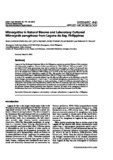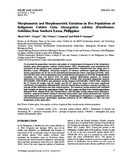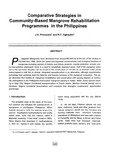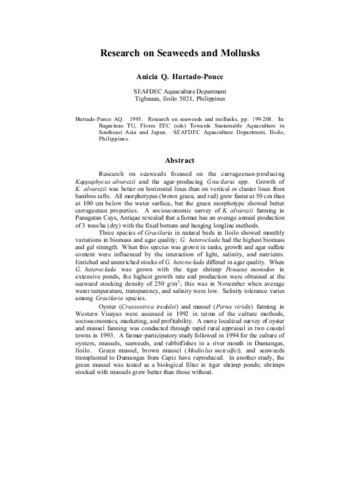Microcystins in natural blooms and laboratory cultured Microcystis aeruginosa from Laguna de Bay, Philippines.
Share
Abstract
Laguna de Bay, the largest freshwater lake in the Philippines, experiences periodic blooms of the cyanobacteria Microcystis aeruginosa. Blooms of these cyanobacteria in 1996, 1998 and 1999 were sampled. HPLC and MALDI-TOF mass spectrometry were used to analyze for microcystins. A total of 16 structural variants of the toxin were isolated from the samples with microcystin LR (MC-LR) as the most abundant variant in the samples from 1996 and 1999 making up 77 to 85% of the total, respectively. MC-RR was the dominant variant in the 1998 bloom making up 38%. The samples from 1996 had the highest total toxin concentration (4049 µg g-1) followed by those from 1998 (1577 µg g-1) and 1999 (649 µg g-1). A strain of M. aeruginosa previously isolated from the lake was also cultured in the laboratory under different nitrogen concentrations (1, 3 and 6 mg L-1) and elevated phosphorus concentration (0.5 mg L-1) to determine the influence of these factors on toxin production. A total of 9 different structural variants of microcystin were isolated from the laboratory cultures with MC-LR consisting more than 75% of the total in all treatments. No significant differences in the total toxin concentration as well as the % distribution of the different variants among treatments were observed. However, the strain of M. aeruginosa cultured in the laboratory had from 3 to 20 times higher total microcystin than those harvested from the lake.
Suggested Citation
Cuvin-Aralar, M. L., Fastner, J., Focken, U., Becker, K., & Aralar, E. V. (2002). Microcystins in natural blooms and laboratory cultured Microcystis aeruginosa from Laguna de Bay, Philippines. Systematic and Applied Microbiology , 25(2), 179-182. https://doi.org/10.1078/0723-2020-00102
Subject
Collections
- AQD Journal Articles [1249]
Related items
Showing items related by title, author, creator and subject.
-
Morphometric and morphomeristic variations in five populations of indigenous Celebes goby Glossogobius celebius (Perciformes: Gobiidae) from Southern Luzon, Philippines
Corpuz, Mark Nell C.; Camacho, Ma. Vivian C.; Ocampo, Pablo P. (College of Agriculture, University of the Philippines Los Baños, 2013)To elucidate the population structure and pattern of morphological divergence of the indigenous Celebes goby Glossogobius celebius (Valenciennes, 1837), morphometric and morphomeristic characters of this species were ... -
Comparative strategies in community-based mangrove rehabilitation programs in the Philippines
Primavera, Jurgenne H.; Agbayani, Renato F. (United Nations Educational Scientific and Cultural Organisation; Japanese Man and the Biosphere National Committee; Mangrove Ecosystem Research Centre, 1997)Philippine Mangroves have decreased from around 500,000 ha at the turn of the century to 132,000 ha in 1990. Given the varied and important socioeconomic and ecological functions of mangroves including harvest of forestry ... -
Research on seaweeds and mollusks
Hurtado-Ponce, Anicia Q. (Aquaculture Department, Southeast Asian Fisheries Development Center, 1995)Research on seaweeds focused on the carrageenan-producing Kappaphycus alvarezii and the agar-producing Gracilaria spp. Growth of K. alvarezii was better on horizontal lines than on vertical or cluster lines from bamboo ...




